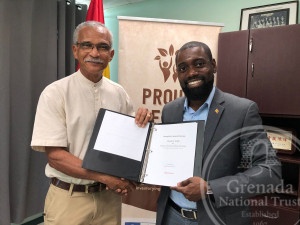 A book that all Grenadians must have
A book that all Grenadians must have
Every now and again, you come across a piece of work or reference material, that is so relevant and majestic that you wonder how you’d missed it. This book is one of those cases, and I’m sure if I missed it, many thousands of Grenadians both at home and abroad did too. Whatever, the reason, the time has come to recognise and share this magnificent book.
It is packed with information that straightens out the history books once and for all. It’s presented in a style that is easily digested by all readers and every page holds text or images that capture the soul and essence of our beautiful tri-island state from every perspective.
I personally, have a passion for all things Grenadian, but must confess to having seen the title on the book shelves but passed it by as though it were written for tourists. I could not have been more wrong. This book has been compiled with a real since of love and passion for the content that resides within and the subject matter of Grenada. It is written with an understanding that much of our history has been misquoted or has been contradictory.
Marcus Garvey, once said “a people with no knowledge of its history, is like a tree without roots, it can not grow”. John Angus Martin, with this book, has given us a great foundation to piece together our history for current and future generations to embrace in their everyday lives.
This book should be in every Grenadian home wherever you reside on the planet. (MA, May 2013)
 About the Author
About the Author
John Angus Martin was born and grew up in St. George?s, Grenada, where he attended the St. George?s Roman Catholic Boys? School (now known as the J.W. Fletcher Memorial Boys? School) and Presentation Brothers? College before immigrating to Brooklyn, New York with his family in 1978.
He graduated in 1986 with a BSc in Biological Sciences and a minor in Anthropology from the State University of New York at Stony Brook, Long Island.
He spent the next three years as a Peace Corps volunteer in Sierra Leone, West Africa, teaching at an agricultural institute and as an agricultural extension agent to subsistence farmers in rural villages. He has travelled widely in west and east Africa for work and as a visitor.
He holds master?s degrees in History, and Agricultural and Applied Economics from Clemson University, South Carolina. He?has worked?as aReference Archivist at the Cushing Memorial Library, Texas A&M University and a?Country Desk Officer in the Africa Region of the US Peace Corps,and traveled to many countries in west and east Africa. These travels have been important in his study of Caribbean slavery and colonialism.. He?is currently the director of the Grenada National Museum.?His next project,?French Grenada: Island Caribs and French Settlers, 1498-1763?explores the rise and demise of the French in Grenada, will be published in July.
What the reviews say:
Amazing!!!!,?January 12, 2008
This review is from:?A-Z of Grenada Heritage (MacMillan Caribbean) (Paperback)
It makes great reading for those of us who of Grenadian heritage but have lost the connection to our culture. The book provides valuable historical information that is often lost over time and is a wonderful tool that I can share with my daughter.
Dip Into A-Z of Grenada Heritage for Island Gems,?November 25, 2007
This review is from:?A-Z of Grenada Heritage (MacMillan Caribbean) (Paperback)
“A-Z of Grenada Heritage” is an oversized, 283-page, color illustrated [on quality paper] compendium of useful information about multiple aspects of the island of Grenada.
John Angus Martin writes to the point and provides facts of historical and contemporary information in an easily understandable manner. Excellently chosen photographs and illustrations catch one’s interest.
Martin backs up his knowledge with references.
A partial entry example:
“FISHERMAN’S BIRTHDAY is a Roman Catholic festival celebrated on 29 June each year as the feast of St. Peter and St. Paul. In the town of GOUYAVE, one of the largest fishing communities in the islands, festivities are the ‘grandest’ and are attended by visitors from all across Grenada. Under the French the parish was dedicated to St. Pierre, the patron saint of fishermen. After church services in each parish and the blessing of fishermen’s boats and nets, there are boat races, eating, drinking and merrymaking for the remainder of the day; the merrymaking dates to the mid-1960s . . .”
“A-Z of Grenada Heritage” is recommended for library ‘Country’ collections, for every travel and tourist-related organization’s reception area, for those who live on the Spice Isle, for those who visit Grenada, and for those who plan to visit Grenada.
The book is a delight; there’s nothing quite like it.
Great Book,?May 5, 2008
This review is from:?A-Z of Grenada Heritage (MacMillan Caribbean) (Paperback)
I was born in Grenada but grew up here in the US. My parents and other family members made sure that I knew my culture. Although I have been back there many times,after reading this book, I was able to get eeven more knowledge of all that was instilled in my cultural knowledge by them. It is a great conversation book between family and friends who are not from Grenada. Well worth the read and the money.
A valuable resource,?March 7, 2008
This review is from:?A-Z of Grenada Heritage (MacMillan Caribbean) (Paperback)
This book is a valuable resource for anyone seriously interested in Grenada. It is an enjoyable and informative read.
?
?A-Z of Grenada,?November 20, 2010
This review is from:?A-Z of Grenada Heritage (MacMillan Caribbean) (Paperback)
It is good, Enjoying it….Well Please…Even though, like a Rasta, I have different opinion on many Subjects…But it is cool..Just have some over standing..You done know how that go….Seen!
A-Z Grenada Heritage,?December 16, 2008
This review is from:?A-Z of Grenada Heritage (MacMillan Caribbean) (Paperback)
This book provide a great overview of Grenada, it’s people and it’s culture. Great Read!!





